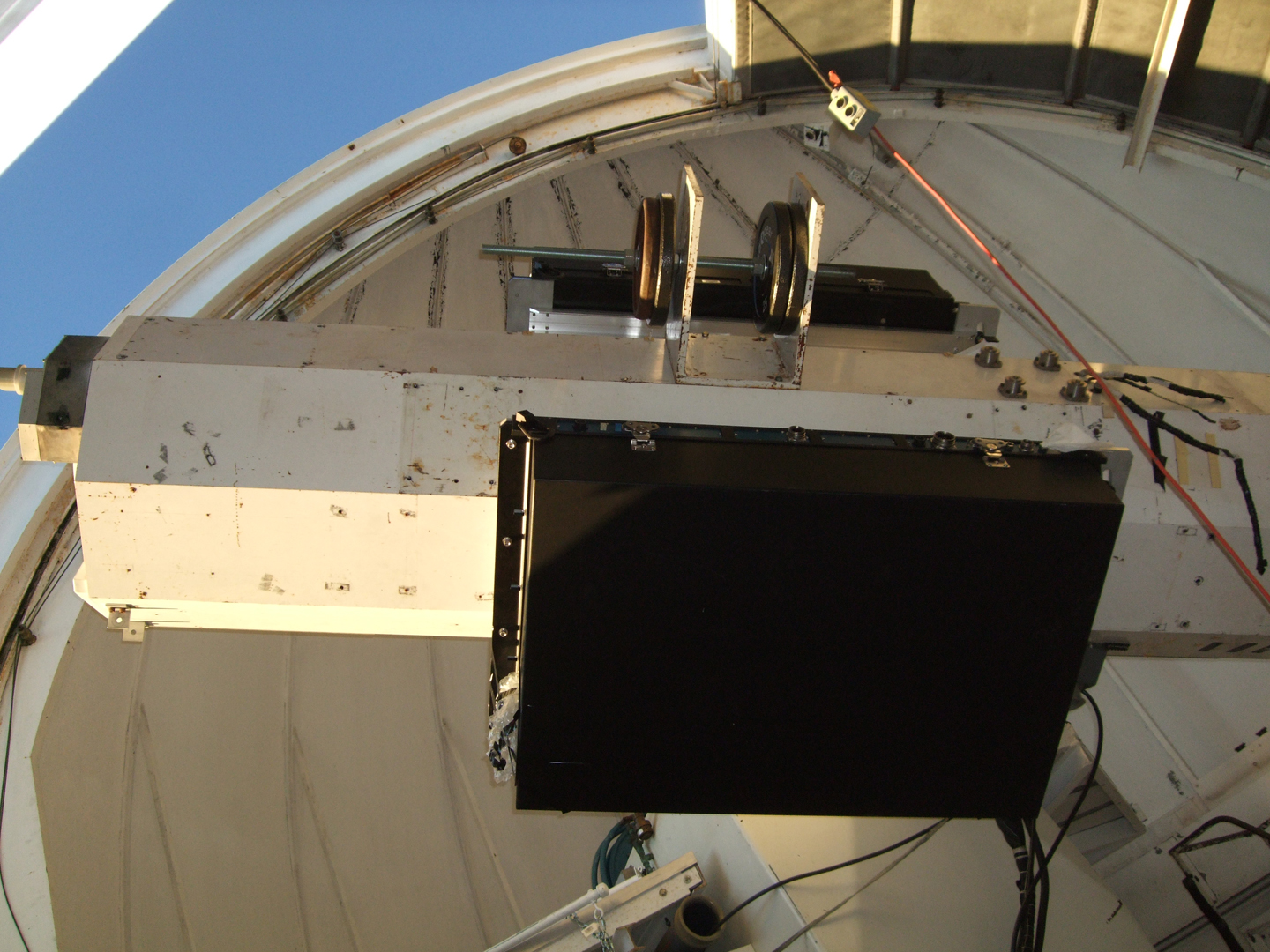
- Mees Home
- Haleakala Weather
- Web Cams
- Planets
- Day-Night
Seeing Monitor Archive - MSO Archived Instruments
- Weather Links
- Other Links
Magneto Optical Filter Instrument
Overview
A partnership between the IfA and NASA/JPL has developed a suite of four 20 cm aperture Doppler-magnetographs that image the full solar disk with a spatial resolution of 4 arc-seconds and a temporal resolution of 5 seconds. Each instrument uses a magneto-optical filter to simultaneously provide the line-of-sight Doppler velocity and line-of-sight magnetic field strength at a given height in the solar atmosphere with a sensitivity of ~7 m/s and ~5 G, respectively, per image pixel. This is comparable with the sensitivities of the HMI/SDO instrument (13 m/s and 10 G in 45 seconds) when adjustment is made for the difference in spatial resolution.
By using a different MOF in each instrument (Na, K, Ca and He), we are able to simultaneously measure the velocity and magnetic fields at different heights in the solar atmosphere, from the photosphere to the high chromosphere.
Two of the instruments (running Na at 589 nm and K at 770 nm) are currently mounted on the spar at Mees Solar Observatory. These instruments provide observations at ~ 400 km and 600 km above the base of the photosphere. The other two instruments (He at 1083 nm and Ca at 422 nm) are currently at the IfA's ATRC Laboratory in Pukalani. The helium instrument is the first of its kind and has provided high-quality intensity data [1]. The next step is to develop velocity and magnetic field capability. The calcium instrument is also the first of its kind and is under construction (90% completed).
Each instrument is based on the same optical and mechanical design and, except for the MOFs and custom dielectric coatings on each set of optics, is essentially identical. The instruments are built so that they can also be used for campaign runs at South Pole Solar Observatory for projects that require long, uninterrupted observation of the Sun.
The primary purpose of the MOTH II instrument suite is to provide multi-height observations for helioseismic probing of the Sun's interior and atmosphere via studies of the omnipresent Magneto-Acoustic-Gravity waves in the solar atmosphere. However, the data also have relevance to Space Weather studies.
 |
| The Na and K MOTH instruments mounted on the spar at Mees Solar Observatory on Mount Halealaka, Hawai’i |
Brief History
The original MOTH I instrument was a dual-channel instrument running Na and K MOFs with 5 cm apertures. The instrument was deployed to South Pole in 2002 where a 107-hour set of 10-second cadence data provided a proof-of-concept for helioseismic probing of the solar atmosphere [2-4]. Upgrading the aperture to 20 cm (MOTH II) required a complete re-design of the instrument and resulted in four independent instruments. The new design was validated for Antarctic observations in 2008. The mechanical design was modified in 2010 to allow for mounting on the spar at Mees Solar Observatory. A new award from NSF is allowing us to upgrade the spatial resolution of the Na and K instruments to 2 arc-seconds. The upgrade will take place in 2015. For a full description of the MOF design and how it functions, we refer the reader to the work of Cacciani and Fofi [5] and Tomczyk et al [6].
 |
 |
A view of the MOTH II instrument package (left) and the MOTH II Na and K instruments deployed at |
|
Team Members
Stuart Jefferies (Principle Investigator, IfA)
Neil Murphy (Co-Investigator, Jet Propulsion Laboratory)
Cynthia Giebink (Software Engineer, IfA)
Allister Knox (Optics and Electronical Engineer, IfA)
Current Scientific Studies using MOTH II Data
Internal Gravity Waves in the Sun’s Atmosphere (IfA/JPL/ESA/HAO)
Space Weather Prediction (Univ. of Rome Tor Vergata/IfA/JPL)
References
[1] Murphy, N., Smith, E., Rodgers, W. and Jefferies, S. M. 2005, “Chromospheric Observations in the Helium 10830 nm Line: A New Instrument”, Solar Wind 11 - SOHO 16 "Connecting the Sun and heliosphere" ESA SP-592.
[2] Jefferies, S. M., McIntosh, S. W., Armstrong, J. D., Bogdan, T. J., Cacciani, A. and Fleck, B. 2006, “ Magneto-Acoustic Portals and the Basal Heating of the Solar Chromosphere”, ApJ, 648, L151-L156
[3] Finsterle, W., Jefferies, S. M., Cacciani, A., Rapex, P. and McIntosh, S. W. 2004, ``Helioseismic Mapping of the Magnetic Canopy in the Solar Chromosphere”, Ap.J., 613, L185-L188
[4] Finsterle, W., Jefferies, S. M., Cacciani, A., Giebink, C., Knox, A., Rapex, P. and DiMartino, V. 2004, “Seismology of the solar atmosphere”, Solar Physics, 220, 317-331
[5] Cacciani, A. & Fofi, M. 1978 “The magneto-optical filter II – velocity field measurements”, Solar Physics, 59, 179
[6] Tomczyk, S., Streanfer, K., Card, G., Elmore, D. & Hull, H. 1995, “An instrument to observe low-degree solar oscillations”, Solar Physics, 159, 1